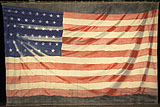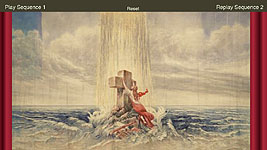
CLICK TO ENLARGE
Scenic Drops

SEE TRANSFORMATION SCENE
 CLICK TO ENLARGE |
Scenic Drops |
 SEE TRANSFORMATION SCENE |
| These are images of 12 canvas drops that the Harmount UTC Company carried with them as they toured the midwest during the early 20th century: |
 |
 |
 |
 |
 |
 |
 |
 |
|
| |||||||
 |
 |
 |
 |
 |
 |
 |
 |
| You can get an idea of the size of the originals by clicking on THIS
IMAGE, which shows a dozen students from Ohio State University's
Department of Theatre during the session at which the drops were hung and
photographed. They were designed by M. Armbruster & Sons, Scenic Artists, at their studio in Columbus, probably as part of the order from Harmount's being discussed in THIS 1915 LETTER from Emil Armbruster. Aniline dye was used instead of paint to allow them to be folded and unfolded hundreds of times without cracking. The letter mentions 14 drops. From the set above at least two seem to be missing: the backdrop for the ice scene and a leg drop for the auction scene. On the other hand, Harmount's could have used "house" drops for those pieces; small touring companies relied on the theaters they were booked into to furnish many of the drops for a performance, as you can see from THIS CHECK LIST of sets and lighting: on the list, "house" means they expected to use whatever the theater had available, while "Co." meant the company carried the drop with them. It's not easy to say EXACTLY HOW MANY DROPS the Harmont company toured with in 1915. But certainly the drops above are sufficient to provide a good sense of the look of a touring "Tom Show," especially the kind of effect aspired to at the conclusion, in what most companies referred to as "The Grand Allegorical Transformation Scene," during which Tom dies on stage and theater-goers are transported into the realm of the blessed, perhaps with the help of Eva dressed as an angel and suspended on wires from the flies -- to view a FLASH animation of the Transformation scene, CLICK HERE. To give an idea of how the drops looked to audiences when full stage and leg drops were combined, and the proscenium arch cut off the wires and edges, here are cropped images of TOM'S CABIN and the ROCKY PASS. As they waited for the play to start, audiences probably stared at the FLAG CURTAIN above left -- which may have been a special touch added around the time of the Great War. Armbruster & Sons designed scenic effects for many different kinds of theatrical companies, and thousands of productions. The Jerome Lawrence & Robert E. Lee Theatre Research Institute at the Ohio State University, in whose Harmount Collection these 12 drops are preserved, also contains the Armbruster Collection. Among its items are the following 4 watercolor designs for UTC scenic drops; there's no indication of when they were drawn, or what company they were intended for, or if they were ever produced, but they offer a suggestion of both the process by which designers created the scenes and of the variety of illusions by which Tom Show audiences were entertained: |
 |
 |
 |
 |
